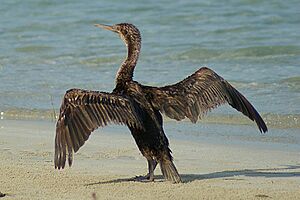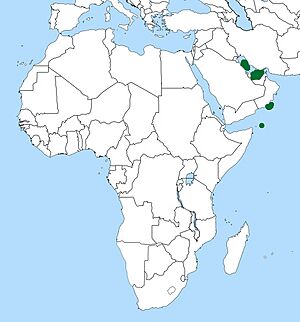Socotra cormorant facts for kids
Quick facts for kids Socotra cormorant |
|
|---|---|
 |
|
| Conservation status | |
| Scientific classification | |
| Genus: |
Phalacrocorax
|
| Species: |
nigrogularis
|
 |
|
| Synonyms | |
|
Anacarbo nigrogularis |
|
The Socotra cormorant (Phalacrocorax nigrogularis) is a special type of cormorant bird. It is considered a threatened species, which means its numbers are getting low. This bird lives only in certain areas, mainly around the Persian Gulf and the south-east coast of the Arabian Peninsula. This is called being endemic to a region.
People sometimes call it the Socotran cormorant or, less often, the Socotra shag. These birds can sometimes fly as far west as the Red Sea coast. Even though it's called the Socotra cormorant, scientists only confirmed in 2005 that it nests on the Socotra islands in the Indian Ocean.
Contents
What Does the Socotra Cormorant Look Like?
The Socotra cormorant is mostly black. It grows to be about 80 centimeters (31 inches) long.
Colors and Features
When it's time for them to breed, their head feathers can look a bit purplish. Their back feathers might have a slight green color. You might also see a few white feathers around their eyes and neck. They can also have some white streaks near their tail.
Their legs and feet are black. The skin under their chin, called the gular skin, is also blackish. Outside of the breeding season, these special colors and white marks are not as noticeable.
What Do Socotra Cormorants Eat?
Scientists don't know a lot about what these birds eat or how they find their food. Like all cormorants, they dive underwater to catch their meals.
Diving for Food
Some older reports say that Socotra cormorants can stay underwater for up to three minutes. This is a very long time for a cormorant! It suggests they might be able to dive very deep to find food. However, other reports say they often hunt in large groups. Birds that hunt in groups usually find their food closer to the water's surface.
How Do Socotra Cormorants Live Together?
These birds love to be in big groups. They are very social animals. People have seen huge groups of them resting together, with as many as 250,000 birds! When they are out at sea, flocks can have up to 25,000 birds.
Why Are Socotra Cormorants Threatened?
Since the year 2000, the Socotra cormorant has been listed as a Vulnerable species on the IUCN Red List. This list helps track animals that are at risk. The main reasons they are in danger are:
- They have only a few places where they can breed.
- Their numbers are quickly going down.
Threats to Their Homes
The biggest dangers to these birds come from things happening near their nesting areas. These include:
- New buildings and developments along the coast.
- People disturbing them when they are nesting.
- Pollution in the ocean.
In 2000, experts thought there were about 110,000 breeding pairs of Socotra cormorants. This means there were around 330,000 to 500,000 individual birds in total.
Important Nesting Sites
One of the most important protected nesting places is on the Bahraini Hawar Islands. This area is off the coast of Qatar. About 30,000 pairs of cormorants nest there. This site is so important that it's protected by an international agreement called the Ramsar Convention. Out of 13 known nesting areas, the Hawar colony is the largest.
Sadly, in the northern part of their home range, about 12 nesting colonies have disappeared since the 1960s.
Oil Pollution
Socotra cormorants are also affected by oil pollution in the sea. During the Gulf War (also known as the First Gulf War), many pictures were shown in the news of birds covered in oil. While other cormorants live in the Persian Gulf, it's very likely that many of those birds were Socotra cormorants.
Conservation Efforts
In 2012, the Environment Agency – Abu Dhabi (EAD) worked to keep track of wild birds in Abu Dhabi. They checked nearly 60 different places and found 420 different kinds of birds. They recorded almost 12,000 breeding pairs of the threatened Socotra cormorant on five or six small islands in the area.
The Socotra cormorant is also protected by an agreement called the Agreement on the Conservation of African-Eurasian Migratory Waterbirds (AEWA). This agreement helps protect birds that fly long distances between Africa, Europe, and Asia.


